Constanța Casino
| Constanța Casino | |
|---|---|
|
Native name Romanian: Cazinoul din Constanța | |
| Kursaal; Cazin; Cazinoul Comunal | |
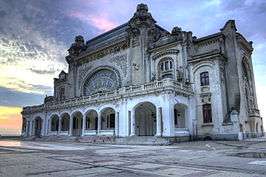 Constanța Casino at sunrise | |
| Location | Constanța County, Romania |
| Nearest city | Constanța |
| Built | 1880 |
| Built for | General Use |
| Demolished | 1891; 1907 |
| Rebuilt | 1893; 1910 |
| Restored | Many restorations occurred |
| Restored by | Various; (ex. Daniel Renard and Securitate) |
| Current use | Abandoned |
| Architect | Daniel Renard; Petre Antonescu |
| Architectural style(s) | Art Nouveau |
| Governing body | Ministry of Culture and National Patrimony (Romania) |
| Type | Architectural Monument of National Interest |
| Designated | 2004 |
| Part of | National Register of Historic Monuments (Romanian: Lista Monumentelor Istorice (LMI)) |
| Reference no. | CT-II-m-A-02801 |
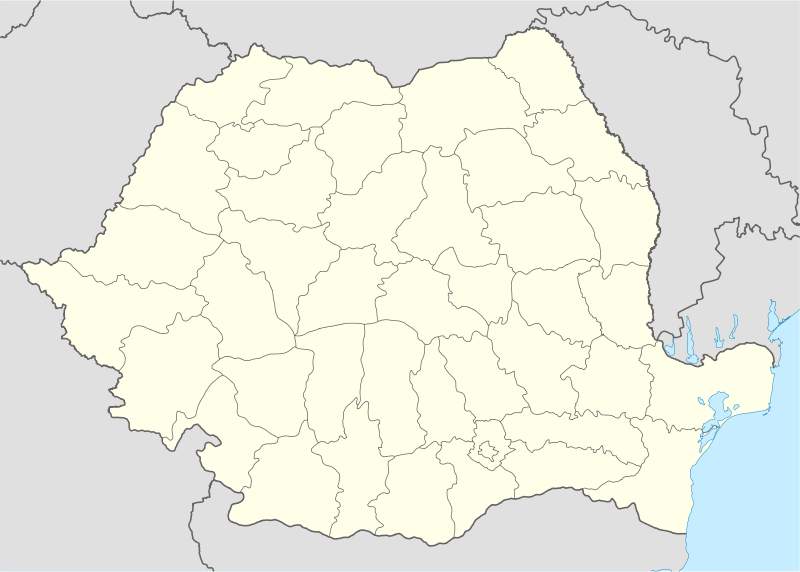 Location of Constanța Casino in Romania | |
The Constanța Casino (Romanian: Cazinoul din Constanța) is a casino located in Constanța, Romania. It has been designated by the Romanian Ministry of Culture and National Patrimony as a historic monument.[1] The casino is on the Constanta boardwalk at 2 Elisabeta Boulevard along the Black Sea in the historic Peninsulă District of the city. The casino was built three separate times, with the first structure being erected of wood in 1880. It was designed to be a club and community center for elite and upper-class socialites willing to spend. Once considered Romania's Monte Carlo and a symbol of the City of Constanța, the most-recent and modern version was built in Art Nouveau style, also being the most important Art Nouveau building in the country, designed and built according to the plans of Daniel Renard and inaugurated in August 1910.[2] The most modern version of the Casino was in operation for 38 years, with interruption due to the two world wars, attacked and bombed by Bulgarian and German troops in World War 1, ravaged in World War 2 and, at one point, acted as a makeshift wartime hospital. In 1948 it was taken over by the Communist government becoming a House of Culture (Casa de Cultură a Sindicatelor) for the party until 1960 when it was handed to the National Office of Tourism Oficiul National de Turism (ONT). The last major repairs took place in 1986-1988, and the building is currently abandoned.[3]
History
Cazin Kursaal (1880–1891)
The first version of the Constanța Casino was built of wood frame in 1880 and was named Cazin or Kursaal (from the German Language). It was the first Romanian building to be built on the shore of the Black Sea shortly after Dobruja came under Romanian administration as a result of the Russo-Turkish War (1877–1878) and the Romanian War of Independence.[4]
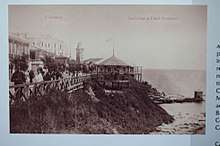
The building utilized slopes to create two rounded overlapping terraces with the purpose of providing a full view of the cliff, the sea and the Constanța harbor from all angles. It was situated adjacent to the Genoese Lighthouse. The interior held a ballroom, two games halls and two reading halls, where visitors could read local, national and international press. Initially, the City of Constanta leased and rented the building and space to entrepreneurs. One of those casino entrepreneurs was Captain Constantin Creanga, son of writer Ion Creanga and father of Horia Creanga, the leading Romanian architect during the interwar period. Shortly after the building was transferred and administered by the County Council which opened it up for use. Finding that the building merely produced enough income to cover maintenance, it was again leased out to wealthy entrepreneurs. Regional nobility would frequent Cazin Kursaal, as captured by locally famed photographer and first Secretary of the French Consulate in Constanța after the Romanian War of Independence, Anatole Magrin.[5] In 1891, the wood structured Cazinoul din Constanța was almost entirely destroyed by a storm and on January 29, 1892 its demolition was approved.
Cazin (1893–1907)
The second version of the Casino was commissioned and built by the City of Constanţa and Mayor Belik at a nearby location and opened its doors in 1893. It was built and situated in approximately the same location as the current Casino and like its predecessor, it too was built of wood frame. It was composed of a dance hall, several rooms but only one terrace to the sea. In May 1902, Captain Constantin Creanga petitioned the local mayor and city management to lease the building. He advertised himself as a chef, a skilled confectioner, and fluent in two commonly-spoken lingua franca of the time. He was successful and the building was transferred to his care for 2,000 Lei a year, with the stipulation that he "sell merchandise and products of only the finest and highest quality" and use "petroleum of the best quality on the property as to not produce any odor when burned" for light.[6]
Romanian Writer, Petre Vulcan, wrote about his impressions of the Casino, "At first sight we were attracted to the party pavilion, whose mammoth feet rise from the waves, with a wrapped porch pushed over the sea. From the interior music sprang, and cheerful couples dance Boston; From outside the lanterns hanging towards the sea dance enchantingly under which noble Ladies and Lords converse intimately, vanishing into the sea of people before them, as in A Thousand and One Nights."[6]
 Second Casino between 1893 and 1910
Second Casino between 1893 and 1910 Terrace of the Casino looking out on the Black Sea
Terrace of the Casino looking out on the Black Sea
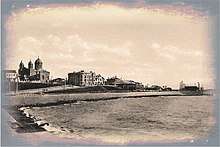
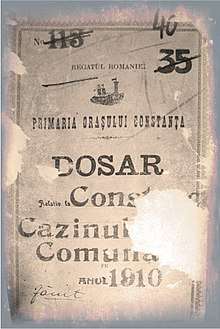
Modern Cazinoul Comunal (1910+)
Construction
In 1903, local politicians agreed that it was time for the City of Constanţa to have a modern casino, "...like those which inspired the French Riviera".[7] The Liberal government at the time immediately approved the project. The project was awarded to Daniel Renard, a Romanian architect of French descent who lived in Constanta. Daniel Renard was 32 years of age and a graduate of the École des Beaux-Arts in Paris. His proposal to build an Art Nouveau structure stirred countless controversy, being supported by liberals in power but harshly criticized by the entire opposition. As the building's foundation was being cast, the politicians that appointed Renard were replaced.[8] Construction halted and Renard was quickly replaced with Petre Antonescu. Antonescu envisioned a theater-like building with two towers in the Neo-Romanian style and thus begins working on the new plans by pouring a second foundation.[9] However, two years after Renard was removed the liberal party regained power in 1907. Renard was reappointed, resuming his project as he had envisioned from the beginning: Art Nouveau style. Renard poured a third foundation.
The works started for a third time in 1907 and was completed in 1910 with a total construction cost of 1.3 million lei, excluding other expenses such as furniture, fittings, architect's commission, etc. Each of the three foundations cost 70,000 lei, the boardwalk cost 370,000 to extract from the sea, the furniture itself cost approximately 90,000 lei while the total costs railings, gratings, chandeliers, lighting fixtures, furniture, other all decorations cost 547,616 lei - according to Romanian Art Critic and Researcher Doina Pauleanu[9] and historic documents in the City of Constanta archives. Historical documents also show that electricity was installed by the Sociertatea Anonima de Gaz of Budapest and railings, gratings, and metalwork items were executed by the Wolf Factory in Bucharest. The asphalt on the outer sidewalk and the iron grating including three gates, were made by the M. Segal Company in Bucharest costing 19,000 lei. The city also purchased a piano from the Otto Harnisch Company in Bucharest and hired an orchestra of 18 people at a cost of 20,000 lei per season.
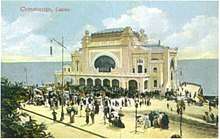
Inauguration and reception
The third and current version of the Casino was inaugurated August 15, 1910, in the presence of Prince Ferdinand. Speeches paying homage to King Carol I, Prime Minister Ionel Brătianu, Minister V. Morţun, and a performance was held by the Davilla Theatre troupe and a celebratory grand ball occurred for Constanta's nobility and elite. After opening, on March 15, 1911, Mayor Titus Cănănău of Constanta leased the building for one-year to Alphonse Heitz, owner of the Café de Paris restaurant in Bucharest. Plowing through political opposition, on the same day the contract was awarded the County Commission authorized gambling, equipping the Casino with two billiard tables and 17 gambling tables for card games. In short time, the casino in Constanta became one of the most popular establishments of its kind in Europe.
The building attracted both admiration and criticism. For example, citing the travel journal of French diplomat George Oudard in 1935, we find that: "One thing which is disappointing in this welcoming place: the white casino, pretentiously complicated, of the most dreadful and horrific style of 1900, which acts to burden the sea coast." The casino did not escape the criticism of local media either, being characterized as a "Hulking heap strewn with all sorts of gewgaws and cheap fineries" by journalists in a March 1910, edition of the Conservatorul Constantei newspaper, while journalists of the publication "Drapelul" in a December 1911 editorial, criticized mayor Titus Cănănău of Constanta for not doing more "to squander time and resources as to hinder the monstrosity".[10] Many of the decriers were against the asymmetric architecture of the building, the gaudy construction elements, and the architectural lines, albeit innovative, that made the building discordant in relation to Romanian neoclassical architecture of the time.
After a year, however, in 1912, the City of Constanta opened a bidding process for management of the Casino. A 20-year lease was awarded to Baron Edgar de Marcay, represented by attorney Nicolae P. Simonide from Bucharest. The Baron was the owner of "the Society of the Great Establishments". As part of the lease agreement, the Society was obligated to construct a luxury hotel for the upper-class clientele of the Casino. The result was the Palace Hotel, inaugurated on July 13, 1914, with 250 rooms with baths, electrical lighting, heating, balconies, a world-class restaurant, and a roof-top terrace.[11] French Architect E.P. Goue received the order for the Hotel project March 28, 1912. A restaurant annex was also built in 1912. By this time, some local newspapers have changed their tune of the structure. The luxury of the casino and world-class gambling attracted the wealthy from all over the world. Many rich socialites would arrive incognito to the Romanian harbor city. The halls of the casino were filled with drama including several tales of those ruined at the tables who found their end by throwing themselves into the sea or shooting themselves in their hotel room.[10][6]
The casino hosted the Russian Imperial Family in 1914.
The Casino would host yearly parties kicking off the tourism and swimming season on the Romanian Riviera. The Sirena publication documented such a festivity stating, "On April 3, 1916, the Casino reopened to a fanfare of public amazement. The reopening presented this season as one of cleanliness and better taste than previous seasons with several upgrades being done to the terrace and billiard tables. As billiard was not available, the immense billiard room was transformed into a large consumption room for food and drink at this time. Barul American (The American Bar) also radically changed in appearance and comfort, introducing many luxurious updates and innovations that had you feeling as if you were in a great European City... In the Great Hall, Emilian Gheorghiu's Orchestra drew public attention through the perfect execution of classic and modern art pieces, especially the use of the Cellos. In the evening after drinks and supper, the auditorium was transformed into a cinematographic projection room where large audiences would gather to view cinematic pieces.".[12]
 Constanta Casino with Patrons
Constanta Casino with Patrons Historic Picture Constanta Casino Boardwalk with Patrons
Historic Picture Constanta Casino Boardwalk with Patrons Interbellic Tourism Guide for Constanta and the Casino
Interbellic Tourism Guide for Constanta and the Casino Interior Staircase of Constanta Casino
Interior Staircase of Constanta Casino Coins from the Constanta Casino
Coins from the Constanta Casino Modern Casino Blueprints
Modern Casino Blueprints View of Lighthouse and Casino
View of Lighthouse and Casino Postcard of Casino with Camel
Postcard of Casino with Camel Casino Terrace with Boardwalk in background
Casino Terrace with Boardwalk in background
First and Second World War
August 20, 1916 when the bombings of Constanta began during World War I by the Germans, the casino building was transformed into a hospital and used by the Red Cross. The nearby Port of Constanta was the primary target of the Germans, but the close proximity of the Casino left it inevitably affected. Ten people were killed in the Casino when it was hit by shrapnel. Images of the bombings of the Constanta shore, including the casino itself, can be found in the Imperial War Museum of the United Kingdom (IWM). The casino became functional and reopened November 19, 1917. Repairs were finally completed by 1928. The casino was later completely restored between 1934-1937 by initial designer Daniel Renard himself.[13]
In World War II the Casino became host to German troops in 1941 who used the building for accommodation. Once again, the Casino was bombed in June 1941. The targets were the same as in the First World War but this time, the devastation was greater in the Peninsulă district of the city. The war left the Casino abandoned and ruined with both Allied and Russian forces targeting the city and bombing the structure. The aftermath of World War II left the symbolic building surrounded by abandoned sentries and wired fencing.[14]
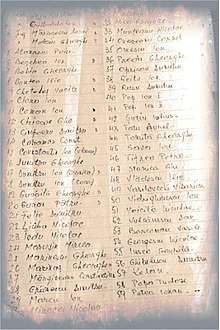
 Windows and Doors destroyed in World War I
Windows and Doors destroyed in World War I Damage to Casino Entryway
Damage to Casino Entryway.jpg) World War I Damage to Casino
World War I Damage to Casino August Von Mackensen with troops near Casino Boardwalk
August Von Mackensen with troops near Casino Boardwalk.jpg) German and Bulgarian WW1 troops Near Casino Boardwalk
German and Bulgarian WW1 troops Near Casino Boardwalk Casino turned into a wartime hospital
Casino turned into a wartime hospital
Casino in the Communist Era
After communism came to Romania, the post-war communist government decided to transform the casino into a House of Culture to support communist propaganda. The casino was renovated by the communist government with a detachment consisting of 100 political prisoners from the Poarta Albă (White Gate) slave-labor camp, under deputy engineer Aurel Mărăşescu. A survivor and laborer attempted to put together a list of prisoners that worked on the project and managed to remember 59 fellow prisoners. He stated, "We work between 12 and 14 hours including Sunday. First time I was a bricklayer. It was all destroyed in that building. There's nothing, no doors, no windows, no fixtures. It was a wreck... ". The prisoners slept in a seaside area, it being the only place in the building where the sky wasn't visible. There was no heat and they were at the mercy of the elements even resorting to eating animal organs, according to one of the prisoners. The project was the same every day. Work, gruelingly and endlessly and then sleep. At the end of July 1952, the building was reclaimed by the three colonels of the Securitate who were responsible with supervising the prisoners and the project; Mr. Albon, Mr. Cozmici, and Mr. Crăciun.[15] In 1956, the building was declared part of the national patrimony.
Modern Era
Due to large operational expenses, the building has remained closed since 1990. The last major repairs of the building took place in 1988.[16]
Constanta City Hall tried to rehabilitate the building in 2006. In 2007, the casino was leased for 49 years to the Israeli "Queen" group. After numerous delays, local authorities took back the building more damaged than before its transfer to the Israeli company.[17] January 2018, Europa Noasta, with the support of the European Investment Bank Institute, as a founding partner, and the Council of Europe Development Bank as an associate partner, listed the Casino as one of 7 most endangered sites in Europe.[18]
In 2014, the edifice was transferred to the administration of the Companiei Naționale de Investiții or National Investment Company as a final rescue solution. An auction was held to award the contract for the execution of rehabilitation work in the casino, with 5 private companies signing up. All five firms were disqualified from auction due to not meeting minimum qualification standards set by the government. A period of appeals and litigation followed, meanwhile the casino remained abandoned.
10 Million Euros have been allocated to the rehabilitation of the Casino but due to litigation and political frenzy, the money and Casino have remained untouched. The mayor of Constanta in 2018, Decebal Fagadau, announced that the City of Constanta will begin public works and conservation efforts. Finalization of the works are to occur in November 2018, on Dobrogea Day, independent of the National Investment Company's auction date.[19]
Notes
- ↑ (in Romanian) Lista Monumentelor Istorice 2010: Județul Constanța
- ↑ Amey, Katie (5 July 2015). "All bets are off: Inside the haunting remains of Romania's crumbling ghost casino". MailOnline. Daily Mail. Retrieved 27 March 2018.
- ↑ (in Romanian) Mariana Iancu, "Fascinanta poveste a Cazinoului din Constanța", Adevărul, March 16, 2015
- ↑ "Cazino Constanta". Litoralul Romanesc. Retrieved 27 March 2018.
- ↑ Iancu, Mariana (1 January 2015). "Anatole Magrin, The First Photographer of Constanţa". Adevărul Newspaper. Retrieved 27 March 2018.
- 1 2 3 Hasnas, Dorothee. "Cazinoul Din Constanta, 1910-2005". Hasnas.com. Retrieved 28 March 2018.
- ↑ Tanase, Gabriela (2014). "The Evolution of Tourist Resorts Constanta, 1878-1941". Journal of Industrial Design. 9 (Special Issue): 19–27, p9.
- ↑ "Cazinoul din Constanța: o scurtă istorie a splendorii art-deco într-o lume din linii drepte". Avantaje. 28 March 2017. Retrieved 27 March 2018.
- 1 2 Pauleanu, Doina (3 December 2011). ""Despre Cazino a scris şi Eminescu" - criticul de artă Doina Păuleanu a lansat prima monografie a edificiului de la malul mării". Adeveral Newspaper. Retrieved 28 March 2018.
- 1 2 "Cazinoul Constanta". Mizuumi.ro. Mizuumi. Retrieved 28 March 2018.
- ↑ Nica, Cristina. "Poveştile misterioase ale Hotelului Palace". ArcheoHeritage. Retrieved 28 March 2018.
- ↑ "Curierul Sezonului la Constanta". Sirena. Annual 1 (2): 1. 4 April 1916.
- ↑ Ionescu, Sinziana (2 March 2018). "FOTO VIDEO Cazinoul din Constanţa, după bombardamentul din 1916. Starea edificiului, asemănătoare celei de azi". Adevarul. Retrieved 2 April 2018.
- ↑ "Istoria zbuciumata a Cazinoului din Constanta". Litoral Cazare. Gaviota. Retrieved 2 April 2018.
- ↑ Cornescu, Radu. "Cazinoul din Constanţa - zbucium de istorie". Retrieved 29 March 2018.
- ↑ Robroek, Roman (20 April 2016). "Shooting One of the Most Beautiful Abandoned Buildings in the World". PetaPixel. Retrieved 30 June 2016.
- ↑ "Cazinoul, TOT ÎN PERICOL! Autoritățile îl "salvează" cu... promisiuni". Telegraf Online Romania. Retrieved 2 April 2018.
- ↑ Schipor, Catalin (14 March 2018). "Pare să răsară soarele pentru Cazinoul din Constanța. A fost inclus pe lista cu cele mai periclitate situri din Europa". Constanta News. CT News. Retrieved 2 April 2018.
- ↑ Ivanov, Catiusa (15 March 2018). "Cazinoul din Constanta a fost inclus pe lista celor mai periclitate situri din Europa in 2018". HotNews.Ro. Hot News Romania. Retrieved 2 April 2018.
| Wikimedia Commons has media related to Constanţa Casino. |